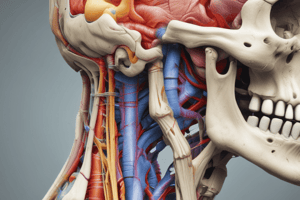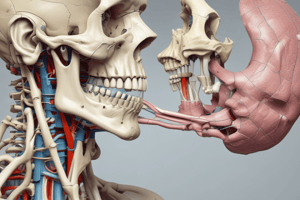Podcast
Questions and Answers
What type of joint is the temporomandibular joint (TMJ)?
What type of joint is the temporomandibular joint (TMJ)?
- Diarthrosis (correct)
- Synarthrosis
- Amphiarthrosis
- Fibrous joint
What is the function of the articular disc in the TMJ?
What is the function of the articular disc in the TMJ?
- It strengthens the joint capsule
- It attaches to the zygomatic arch
- It splits the TMJ into an upper and lower compartment (correct)
- It limits lateral movements
Which ligament limits posterior movements of the TMJ?
Which ligament limits posterior movements of the TMJ?
- Medial temporomandibular ligament
- Lateral temporomandibular ligament (correct)
- Sphenomandibular ligament
- Stylomandibular ligament
What is the name of the region where the TMJ is located?
What is the name of the region where the TMJ is located?
What type of movement occurs in the lower compartment of the TMJ?
What type of movement occurs in the lower compartment of the TMJ?
What happens when the condyloid process moves beyond the articular tubercle?
What happens when the condyloid process moves beyond the articular tubercle?
What is the function of the Coronoid Process?
What is the function of the Coronoid Process?
Which of the following bones forms the zygomatic arch?
Which of the following bones forms the zygomatic arch?
What is the function of the Mandibular Notch?
What is the function of the Mandibular Notch?
What is the nerve responsible for providing sensory innervations to the chin and some of the mandibular teeth?
What is the nerve responsible for providing sensory innervations to the chin and some of the mandibular teeth?
What is the movement of the jaw caused by the contraction of the platysma, mylohyoid, anterior belly of digastric, geniohyoid, and lateral pterygoid muscles?
What is the movement of the jaw caused by the contraction of the platysma, mylohyoid, anterior belly of digastric, geniohyoid, and lateral pterygoid muscles?
Which artery supplies the structures of the mandible?
Which artery supplies the structures of the mandible?
Which of the following muscles has two heads that attach to the condyloid process of the mandible?
Which of the following muscles has two heads that attach to the condyloid process of the mandible?
What is the primary action of the Lateral Pterygoid muscle?
What is the primary action of the Lateral Pterygoid muscle?
What is the most common form of displacement of the condyloid process?
What is the most common form of displacement of the condyloid process?
Which cranial nerve is responsible for innervating the muscles of mastication?
Which cranial nerve is responsible for innervating the muscles of mastication?
What is the name of the ganglion of the Trigeminal nerve?
What is the name of the ganglion of the Trigeminal nerve?
What is the origin of the Trigeminal nerve?
What is the origin of the Trigeminal nerve?
Which branch of the Frontal Nerve is responsible for the skin of the upper eyelid?
Which branch of the Frontal Nerve is responsible for the skin of the upper eyelid?
What is the function of the Ciliary ganglion?
What is the function of the Ciliary ganglion?
Which nerve exits the Middle Cranial Fossa through the Foramen Rotundum?
Which nerve exits the Middle Cranial Fossa through the Foramen Rotundum?
What is the name of the nerve that runs above the pulley of the superior oblique muscle?
What is the name of the nerve that runs above the pulley of the superior oblique muscle?
Which nerve is responsible for the innervation of the Dura mater?
Which nerve is responsible for the innervation of the Dura mater?
What is the path of the Maxillary Nerve after it exits the Foramen Rotundum?
What is the path of the Maxillary Nerve after it exits the Foramen Rotundum?
What is the name of the triangle formed by the anterior border of the SCM and the superior belly of the omohyoid?
What is the name of the triangle formed by the anterior border of the SCM and the superior belly of the omohyoid?
Which of the following muscles is NOT an infrahyoid muscle?
Which of the following muscles is NOT an infrahyoid muscle?
What is the name of the bony landmark that serves as a reference point for the superior nuchal line?
What is the name of the bony landmark that serves as a reference point for the superior nuchal line?
Which of the following muscles is an example of a suprahyoid muscle?
Which of the following muscles is an example of a suprahyoid muscle?
What is the name of the cartilage that is located inferior to the hyoid bone?
What is the name of the cartilage that is located inferior to the hyoid bone?
What is the name of the region formed by the posterior belly of the digastric and the inferior belly of the omohyoid?
What is the name of the region formed by the posterior belly of the digastric and the inferior belly of the omohyoid?
Flashcards
Temporal Bone
Temporal Bone
Bone housing structures for hearing and balance, part of the skull.
Articular Tubercle
Articular Tubercle
A bony prominence that helps limit jaw movement anteriorly.
External Auditory Meatus
External Auditory Meatus
The ear canal that limits jaw movement posteriorly.
Mastoid Process
Mastoid Process
Signup and view all the flashcards
Mandibular Fossa
Mandibular Fossa
Signup and view all the flashcards
Mandibular Foramina
Mandibular Foramina
Signup and view all the flashcards
Mental Foramen
Mental Foramen
Signup and view all the flashcards
TMJ (Temporomandibular Joint)
TMJ (Temporomandibular Joint)
Signup and view all the flashcards
Diarthrosis
Diarthrosis
Signup and view all the flashcards
Lateral Pterygoid Muscle
Lateral Pterygoid Muscle
Signup and view all the flashcards
Condylar Process
Condylar Process
Signup and view all the flashcards
Coronoid Process
Coronoid Process
Signup and view all the flashcards
Inferior Alveolar Nerve
Inferior Alveolar Nerve
Signup and view all the flashcards
Trigeminal Nerve (Cranial Nerve #5)
Trigeminal Nerve (Cranial Nerve #5)
Signup and view all the flashcards
Ophthalmic Nerve
Ophthalmic Nerve
Signup and view all the flashcards
Maxillary Nerve
Maxillary Nerve
Signup and view all the flashcards
Mandibular Nerve
Mandibular Nerve
Signup and view all the flashcards
Ciliary Ganglion
Ciliary Ganglion
Signup and view all the flashcards
Infrahyoid Muscles
Infrahyoid Muscles
Signup and view all the flashcards
Suprahyoid Muscles
Suprahyoid Muscles
Signup and view all the flashcards
Styloid Process
Styloid Process
Signup and view all the flashcards
Sphenomandibular Ligament
Sphenomandibular Ligament
Signup and view all the flashcards
Stylomandibular Ligament
Stylomandibular Ligament
Signup and view all the flashcards
Meniscus (Articular Disc)
Meniscus (Articular Disc)
Signup and view all the flashcards
Jaw Dislocation
Jaw Dislocation
Signup and view all the flashcards
Submandibular Fossa
Submandibular Fossa
Signup and view all the flashcards
Auriculo-temporal Nerve
Auriculo-temporal Nerve
Signup and view all the flashcards
Study Notes
Associated Bones and Important Landmarks
- Temporal bone: has Articular Tubercle/Articular Eminence, which limits the jaw anteriorly and is part of the zygomatic arch
- External Auditory Meatus: limits the jaw posteriorly
- Mastoid Process: located posterior inferior to the mandibular fossa
- Styloid Process: a portion of the temporal bone
Sphenoid Bone and Zygomatic Bone
- No specific landmarks mentioned
Maxilla
- No specific landmarks mentioned
Mandible
- Mandibular/Glenoid Fossa: point where the condyloid process of the mandible articulates with the temporal bone
- Coronoid Process
- Condylar Process
- Mandibular Notch: found between the two superior processes
- Ramus
- Angle
- Neck
- Body: anteriorly, it is lateral to the mental foramina
- Mental Foramen: where mental nerves exit and provide sensory innervation to the chin and some of the mandibular teeth
- Mental Nodes: branches of inferior alveolar nerve and the mandibular division of the trigeminal nerve
- Mandibular Foramina and Submandibular Fossa: located in the internal aspect of the mandible
- Submandibular Gland: pushed up against the fossa
- Inferior Alveolar Nerve: enters the mandibular canal via mandibular foramen
- Blood supply: Superficial Temporal Artery
- Nerve supply: Auriculo-temporal nerve and Masseteric branches of the mandibular nerve
Temporomandibular Joint (TMJ)
- Formed by the articulation of the condyloid process of the mandible and the mandibular fossa of the temporal bone in the infratemporal fossa
- Class: Diarthrosis
- Variety: Ginglymo-arthrodial
- Articular disc/Meniscus: splits the TMJ into an upper compartment and a lower compartment
- Upper compartment: gliding movements such as protrusion and retraction, side-to-side/lateral movements
- Lower compartment: rotational movements such as elevation and depression
- Joint capsule: surrounds the TMJ; supported by extra-capsular ligaments
- Principal ligaments:
- Lateral temporomandibular ligaments: attaches to zygomatic arch and the posterior portion of the neck of the mandible; limits posterior movements
- Medial temporomandibular ligaments
- Accessory ligaments:
- Sphenomandibular ligaments: runs from the ramus of the mandible to the sphenoid bone
- Stylomandibular ligaments: runs from the ramus of the mandible to the styloid process; limits lateral movements
- Dislocation: if the condyloid process moves beyond the articular tubercle
- TMJ is most stable when the jaw is closed
- Lateral Pterygoid muscle: has two heads; both move posteriorly and will fuse and attach to the condyloid process of the mandible
- Action: protrude the jaw and important in opening the mouth; unilateral contraction swings jaw to the contralateral side
- Superior head: attaches to the roof of the infratemporal fossa
- Action: elevates mandible to close the mouth
Cranial Nerve #5: Trigeminal Nerve
- Largest and thickest; has a wide area of distribution
- Semilunar/Gasserian ganglion rests in a depression (trigeminal impression) on the upper part of the apex of the petrous temporal
- Meckel's cave: a fold of dura mater that covers the ganglion
- Mixed sensory nerve
- Sensory: structures of the face
- Motor: muscles of mastication
- Origin: the two roots (larger sensory root and smaller motor root) arise from the lateral part of the inferior surface of the pons Varolii
- Branches:
- Ophthalmic Nerve: smallest division
- Maxillary Nerve: middle cranial fossa
- Mandibular Nerve: largest division
Ophthalmic Nerve
- Branches:
- Frontal Nerve: largest branch and direct continuation of V1
- Lacrimal Nerve: smallest and most lateral branch
- Nasociliary Nerve
- Ciliary ganglion: a small reddish body situated between the lateral rectus and optic nerve
- Short ciliary nerves: 12-14 nerves that arise from the ciliary ganglion
Muscles of the Neck
- Relative to the position of the hyoid bone
- Infrahyoid muscles: below the hyoid bone
- Sternohyoid
- Sternothyroid
- Thyrohyoid
- Omohyoid
- Suprahyoid muscles: above the hyoid bone
- Stylohyoid
- Geniohyoid
- Mylohyoid
- Thyrohyoid
- Digastric
Studying That Suits You
Use AI to generate personalized quizzes and flashcards to suit your learning preferences.




